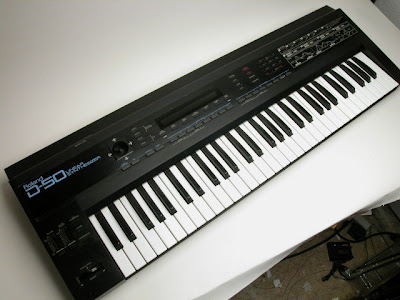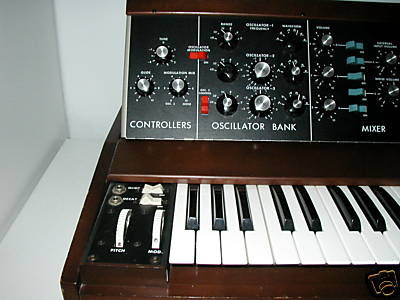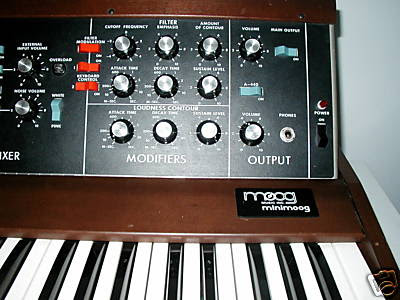 via this auction
via this auction
Friday, May 08, 2009
Yamaha DX7 II-D FM Synthesizer
Note: Auction links are affiliate links for which the site may be compensated.
 via this auction
via this auction
"And the description from Yamaha.com...
Dual and Split Mode
In Dual and Split Modes, two different voices can be played in unison or on separate parts of the keyboard and output in stereo.
Stereo Effects
The Pan parameters not only let the user determine the position of voices in the stereo field according to key touch or when part of the keyboard is played, but also create various special effects such as automatic panning between left and right channels.
Fractional Scaling
Operator output level Scaling can now be programmed individually for each group of three keys, giving the user natural keyboard control over timbre and volume.
Micro Tuning
Micro Tuning gives the user the possibility of "tempering" the instruments in any conceivable way. Preset tuning variations include Equal, Pure (C major, A minor) and Mean Tone temperaments.
Unison Key Modes
In the Unison (mono and Poly) Modes, 4 sound generation units are assigned to each key. These can be detuned to achieve a "fat" sound.
Pitch Bend
Pitch Bend can be programmed so as to affect only the lowest or highest note of a chord, or notes played but not their sustained sound. In addition, pitch bend effects can be controlled by aftertouch or breath controller.
Performance Memories
Save favorite voice combinations along with pan and various control settings in special "Performance" memory.
Glissando Pitch
With the Portamento Step parameter, Glissando Pitch stepping can be regulated from 1 semitone to 1 octave.
Storage of Voices and Performance Data Groups
Store 64 voices and 32 "Performance Data Groups" each in the internal memory and optional RAM cartridge memories for hundreds of voice combinations.
Low Frequency Oscillators (LFO)
The DX7IID has 16 Low Frequency Oscillators (LFO), one for each voice. In the multiple trigger mode, a totally independent LFO cycle can be started for each note played, making ensemble vibrato and tremolo more realistic.
Micro Tuning
Micro Tuning gives the user the possibility of "tempering" the instruments in any conceivable way. Preset tuning variations include Equal, Pure (C major, A minor) and Mean Tone temperaments."

 via this auction
via this auction"And the description from Yamaha.com...
Dual and Split Mode
In Dual and Split Modes, two different voices can be played in unison or on separate parts of the keyboard and output in stereo.
Stereo Effects
The Pan parameters not only let the user determine the position of voices in the stereo field according to key touch or when part of the keyboard is played, but also create various special effects such as automatic panning between left and right channels.
Fractional Scaling
Operator output level Scaling can now be programmed individually for each group of three keys, giving the user natural keyboard control over timbre and volume.
Micro Tuning
Micro Tuning gives the user the possibility of "tempering" the instruments in any conceivable way. Preset tuning variations include Equal, Pure (C major, A minor) and Mean Tone temperaments.
Unison Key Modes
In the Unison (mono and Poly) Modes, 4 sound generation units are assigned to each key. These can be detuned to achieve a "fat" sound.
Pitch Bend
Pitch Bend can be programmed so as to affect only the lowest or highest note of a chord, or notes played but not their sustained sound. In addition, pitch bend effects can be controlled by aftertouch or breath controller.
Performance Memories
Save favorite voice combinations along with pan and various control settings in special "Performance" memory.
Glissando Pitch
With the Portamento Step parameter, Glissando Pitch stepping can be regulated from 1 semitone to 1 octave.
Storage of Voices and Performance Data Groups
Store 64 voices and 32 "Performance Data Groups" each in the internal memory and optional RAM cartridge memories for hundreds of voice combinations.
Low Frequency Oscillators (LFO)
The DX7IID has 16 Low Frequency Oscillators (LFO), one for each voice. In the multiple trigger mode, a totally independent LFO cycle can be started for each note played, making ensemble vibrato and tremolo more realistic.
Micro Tuning
Micro Tuning gives the user the possibility of "tempering" the instruments in any conceivable way. Preset tuning variations include Equal, Pure (C major, A minor) and Mean Tone temperaments."

Labels:
Yamaha
SSL Console Dynamics Card CF82E10
Note: Auction links are affiliate links for which the site may be compensated.
 via this auction.
via this auction.
"This Card is taken from an SSL console (model unknown, but circa 1985 if the QC stickers are anything to go by).
Card is labeled as CF82E10 Dynamics card."
also see SSL console EQ Card CF82E02
Not a synth, but on MATRIXSYNTH-B I have a policy of posting what you send in as a courtesy / thanks for supporting the site.
 via this auction.
via this auction."This Card is taken from an SSL console (model unknown, but circa 1985 if the QC stickers are anything to go by).
Card is labeled as CF82E10 Dynamics card."
also see SSL console EQ Card CF82E02
Not a synth, but on MATRIXSYNTH-B I have a policy of posting what you send in as a courtesy / thanks for supporting the site.
Labels:
SSL
Subscribe to:
Comments (Atom)











